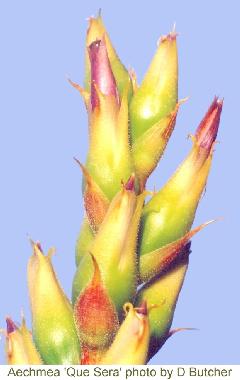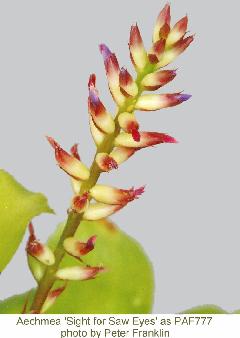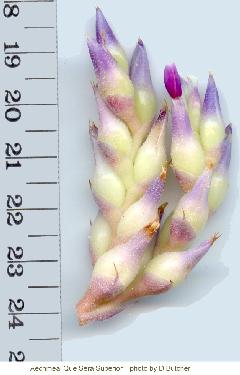Nidularium innocentii. Nidus for nest referring to the sunken inflorescence and innocent for pure for the white petals.
Orthophytum disjunctum The genus name means straight plant referring to the erect scape but as we all know this genus also contains species with no scape! The species name means broken or disjointed, referring to the inflorescence
Pitcairnia bifrons is a real beauty where the taxonomist really knew his mythology! Bifrons was a Roman God who had two heads, one looking at the future, one to the past. Because of this ability he was considered to be a teacher of the sciences
Puya mirabilis means wonderful and is apt for a Puya not as spiny as most and with large green flowers
Quesnelia testudo is fascinating because a testudo describes how the Roman soldiers would interlock their shields to repel attack. Here the floral bracts do the same thing repelling unwanted human interference!
Tillandsia crocata was an easy one once they thought of Crocus
Tillandsia ionantha was covered at the request of the assistant Secretary who has a certain passion for them. At first the members were confused because they knew that antha meant flower but what was the ion. After saying ‘wino’ several times the penny dropped although we had to remember it was red wine we were talking about.
Tillandsia myosurus was for some reason an easy option meaning mouse tail but I was of the opinion it was a poor choice of name. It would have been better described as a dead mouse tail because its leaves are rigid. One which does have a limp mouse tail is T. caliginosa which only means drab!
Tillandsia quaquaflorifera raised lots of laughs and even Bill had a hard job spelling it. Was the Quaqua a duck? No, it means in all directions as in polystichous.
Tillandsia xerographica was an interesting one if only for the reason as to why it is pronounced the way it is. It means dry writing and if ever you do see this species in flower you will have to look carefully at the inflorescence to see such dry writing!
Vriesea carinata was easy because it refers to the floral bracts that have a keel like you find on a boat.
Vriesea elata means tall and refers to the inflorescence and scape. In our case the plant we had on display was typical depauperate size for Adelaide conditions
Vriesea hieroglyphica was an easy one for all but we did find out that Cleopatra was a Greek not an Egyptian!
Vriesea erythrodactylon means red fingers referring to the inflorescence
And so to the plants you thought I had missed. Undoubtedly the one to get most comment was the two bucketfuls of Aechmea that Keith Bradtberg had brought in. It had taken him some 15 years to get this far from seed from the American seed bank and the plants had offsetted many times before one plant per bucketful decided to flower. Was it our dry summer that was the trigger? This saga goes back at least 5 years when Keith surprised us with an oddity we could only call ‘Que Sera’ after the Doris day song – ‘Whatever will be will be’! These current plants have links to that! You may see my quirky sense of humour regarding the linking of the name to the name on the seed packet. You see, the name on the seed packet was Aechmea serrata.
In J. Brom Soc. 55: 207-9. 2005 I pointed out to the Bromeliad World that as far as I was concerned the only true Aechmea serrata was being grown in habitat on Martinique or in Europe. The plant growing in the USA and Australia under this name was an imposter and what I thought seemed closer to A. smithiorum.
Back to the meeting where others including Dave Wecker were mumbling under their breath “Butcher by name and butcher by nature”. This was all because Keith allowed me to remove the inflorescences for scientific purposes. In any event I promised him photos of my achievements and this has been accomplished. The inflorescences were clearly different. One looked like what was being grown as Aechmea serrata on the east coast of Australia and in the USA and the other a large heavy inflorescence with lots of flowers. For want of a name I am calling this one ‘Que Sera Superior’ because there are some links and people will want to grow this plant. What I did find very odd indeed was the branches of the compound inflorescence which were in tandem and only had one primary bract for the two branches - A mixed up kid indeed!
We know that Bill Treloar is growing A. ‘Que Sera’ which is basically a simple spike with a few branches at the base, so he will jump at the chance to get a plant with a decent inflorescence.
While Keith got his seed for ‘Que Sera’ in 1990, Peter Franklin in New South Wales had obtained seed of A. serrata the year before and he was somewhat proud when PAF777 flowered. On seeing the inflorescence I suggested to Peter that he call it ‘Sight for Saw eyes’ but somehow the name and plant died a natural death.
If the seed in the BSI seed bank came from the same source then I have strong views that the A. serrata (now query A. smithiorum) is in fact a hybrid with A. fendleri or A. dichlamydea in its genes somewhere. We do know that Hawaiian and Floridian hybridists were busy hybridising these species in the 1970’s and reluctant to register their progeny. Perhaps this is the answer to our dilemma.



Finally, we do know that Bill Treloar had large Dyckias on display that he had got from the Northern Territory and was hoping I would identify them for him. You may have noticed how I avoided the subject. I have already been through this exercise at the Adelaide Botanic garden where at least their plants were in flower. I got nowhere there, suggesting that hybridity clouded the issue! Bill will have similar challenges!
June meeting from the Secretary’s desk.
Cold? Not really and older members who could not make it were replaced by keen newcomers. Pres. and Vice Pres. were again noticeable by their absence but for different reasons to our previous meeting. This time we were more prepared because I knew that Geoff Jarrett, our newish member from Strathalbyn, had spent many years being a Town Councillor and knew all about meetings. Anyway, he chaired the meeting and kept Bill and I in order. He did a great job at such short notice.
And so to the talk I gave on the Tillandsia tectorum complex. Yes, it was species again only this month it was specific species, not species in general. T. tectorum and its mates mainly come from the dry highlands of the Andes in Peru but some are from Ecuador. Just think of 1000 to 3000 metres altitude with Mount Lofty barely touching 1000m. This group is known for its small, mainly bicoloured, flowers – blue at the base and white at the top with one or two exceptions. They seem to be in an isolated group up there in the high Andes. So much so there is talk from some taxonomists that molecular studies suggest there is a link with the small green flowered Mexicans sometimes treated as a genus of their own called Viridantha! How they are linked after so many thousands of years of evolution is hard to imagine.
We then had a quiz left over from last month and the audience had not warmed up enough to really participate.. What does ‘tectorum’ mean? Stunned silence! Strictly speaking it means of the tiles, but you never see them growing on roofs! What was in the back of Morren’s mind in 1877? We know that Sempervivum or (House Leeks – note spelling) were grown on roofs around the Mediterranean area in Roman times to stop lightning strikes and I assume to stop the roof leaking. But, nothing of this seems to apply in Peru. Perhaps Morren considered the Andes to be the ‘Roof of the World’. Alas we will never know.
It depends how finicky you are as to plant identification because we had a wide range of plants on display with varying certainty as to correct names I have been lucky in being able to acquire plants from Lotte Hromradnik, the author of the book called T. tectorum complex . Here we actually know what plants are referred to. I have other plants I have obtained from other sources where I am less certain as to their identity and I can only stress that if you do have any species plant with collection locality data you keep this reference in a safe place! It is sure to be handy if arguments start as to the correct identity of your plant in the future.
There are 15 different names mentioned in the Tectorum book and thanks to Lotte in Austria and Chris Larson in Melbourne who guided them through AQIS I now have 13 of them.
This talk was originally scheduled as a ‘learn how to use a Tillandsia key’ but I changed my mind. We must remember that my Tillandsia key now covers some 159 names this would be a daunting task to even the experienced key user. As Bill pointed out the terms used by the Butchers of this world may seem fine to them but are gobbledy gook to others. Even with the glossary CD I had supplied him for extracurricular work it was heavy work! So here we have a key for only 15 names in the Tectorum group and many copies were handed out for audience participation! We only tried to use the key on three occasions but in all cases it was evident that you should use a key when things are quiet and you can concentrate on following the series of options. But we did get to the correct result in all three occasions! Mind you they had to take my word on the flowering habits of each species being tested!
The following plants plants and differences to look for were presented.
1. tectorum and vars globosa, viridula and forma gigantea. It seems the var. globosa and var. viridula are rare in Adelaide but we do have forma gigantea
2. balsasensis which has been around for years but the floral bracts are lepidote so it could well be the newly named T. chusgonensis.
3. chusgonensis
4. heteromorpha We have always known that we have two forms of this species – the big one now being known as var. rauhii
5. lithophila
6. malyi
7. oblivata not in Australia as far as I know
8. reducta looks very like a T. tectorum. My next job when it flowers is to see if it agrees with the latest description
9. rupicola not in Australia but because it had been treated for years as a T. tectorum may be around somewhere
10. stellifera is a quaint little plant that reminds you of plants in the Diaphoranthema sub-genus of Tillandsia
11. tomekii
Ones where I had difficulty in getting Lotte to identify purely because my collection data was suspect, are as follows.
1. bolivarensis A Karel Knize name suggesting it was found near Bolivar in Peru somewhere. The trouble is that there are several places with this name!
2. camarcensis A Karel Knize name where Camarco is very popular too!
3. ‘Enano’ This is a plant we have had in Australia for 20 years having come from California but originally from Peru. It is a small plant as the Spanish name implies. However you sometimes come across this plant with the latinised name of Enana or enanum which means not dwarf!
4. Mick Romanowski’s plant which I was proud to have but with no collection data. I await flowering in the next 5 years to see what it may key out to.
By now the willing audience was somewhat shell shocked so we had Bill Treloar talk about the other plants brought in.
Vrieseas and Billbergias can usually be relied upon to show a bit of flower colour in the cooler months. The advantage with the cooler months is that even Billbergias stay around longer. So we saw Vriesea ‘Red Dwarf’, ‘Mariae’ and ‘Purple Cockatoo’ and Billbergia ‘Choc Chill’. The last one having come from WA. Comment was made that while in the past it was difficult to get bromeliads into WA it was now just as difficult to get them out!
Bill had brought in a rootbound plant of Fascicularia bicolor var canaliculata that he had brought back to South Australia from Melbourne during a hot spell last summer. We know that it likes cold weather coming from Southern Chile and does not appreciate the heat. We also know that it is a shy flowerer and should not be planted out in the garden because it makes large prickly clumps quite quickly rather than flowering. There used to be large clumps at the Adelaide Bot Gardens before the Glasshouses got demolished ready for the revamping. These flowered regularly in the winter months. To announce flowering the centre leaves should turn red and Bill showed us a plant that had done this. What was interesting was that this had been on the shady side of the plant but another from the sunny side was setting a flower with a minimum of colour in the leaves! Was the plant trying to attract pollinators to the shady area where it ‘considered’ there was a greater chance of seed being set? Plants seem more intelligent than humans in some respects! Mind you, the domesticated forms never seem to set seed, but do so in Chile. This situation also applies in SW England and Ireland where this plant has almost gone ‘native’!
Bill was also worried why his Nidularium had large spots on its leaves. was this caused by the cold weather. We feel sure it is the cultivar ‘Leprosa’ named many years ago because, I suppose, it reminded someone of leprosy. Bill had better look out for red flowers to see if our guess is right. While on this genus we had a ‘kermesianum’ on display. Botanically speaking this is treated as being just one of the very variable N. procerum but no doubt the name will persist on labels.
It was a pity Len Colgan was not there because we had a flowering Aechmea weilbachii which is a rare event in Adelaide. The prize flowering just had to be a 2 metre tall Vriesea philippo-coburgii. Its owner, Dave Wecker maintained this was the result of letting the plant offset freely and he could well be right.
We had a few tillandias to look at. One was a blast from the past because it still had ‘decomposita’ on the label. this should have disappeared 30 years ago so it shows how old the label was. Perhaps we should have had this name at our May meeting because the name is less than awe inspiring! Its proper name is Tillandsia duratii var. saxatilis.

